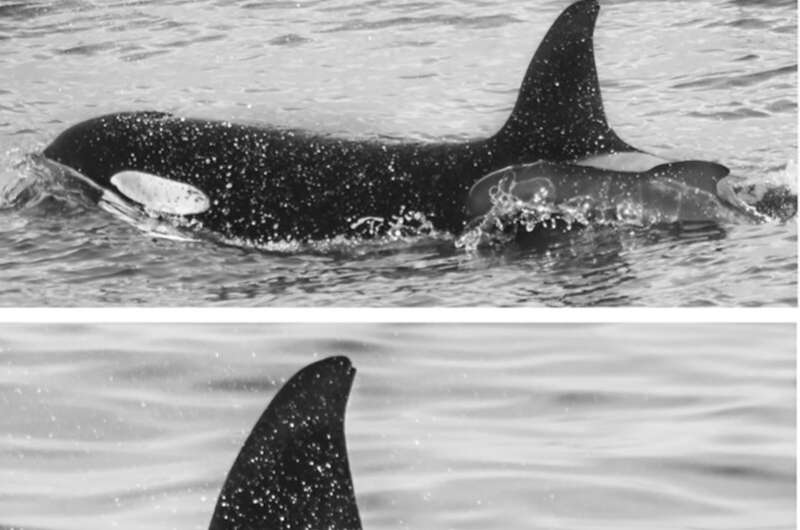March 6, 2023 report
This article has been reviewed according to Science X's editorial process and policies. Editors have highlighted the following attributes while ensuring the content's credibility:
fact-checked
trusted source
proofread
Orca female observed caring for baby pilot whale

A small team of oceanographers from the West Iceland Nature Research Center, Orca Guardians Iceland and Dalhousie University, has observed an adult female orca swimming with and caring for a young long-finned pilot whale. The team outlined their observations of the pair in a paper published in the Canadian Journal of Zoology.
Orca, also known as killer whales, are easily identified by their bright white markings amid dark black skin. They are the largest of the oceanic dolphins. Second largest are pilot whales, which are quite a bit smaller than orca but still much larger than what are generally referred to as simply dolphins. Both are carnivorous and both have a wide range. In this new effort, the team describes their observations of a pilot whale calf traveling with a group of orca.
The research group describes their observation as the first of its type—not only was the calf traveling with a small group of orcas, but it was being cared for by one of the adult females. Such care typically takes the form of encouraging the calf to swim in the echelon position, which is right behind the adult's pectoral fin. In this position, the calf can take advantage of the pressure wave generated by the adult to move at the same pace while exerting far less energy. Care also tends to include protection and feeding. And while the adult female may have been providing protection, it was not able to feed the calf because it was not producing milk.
It is not known how the pilot whale calf came to be cared for by the orca, though the researchers suggest there are likely only two real possibilities. The calf either became separated from its own pod for some unknown reason and was found by the orca, or it was stolen from the original mother.
The researchers were only able to observe the female and calf for a short while; thus, the fate of the calf is unknown, though it has likely died from starvation. The researchers spotted the same adult female, which they have named Sædís, about a year later, interacting with a group of pilot whales. There was no evidence of the calf, but the researchers suggest Sædís was behaving in a way that suggested she might be attempting to steal a replacement.
More information: Marie-Thérèse Mrusczok et al, First account of apparent alloparental care of a long-finned pilot whale calf (Globicephala melas) by a female killer whale (Orcinus orca), Canadian Journal of Zoology (2023). DOI: 10.1139/cjz-2022-0161
© 2023 Science X Network

















